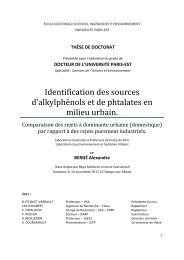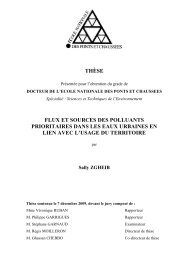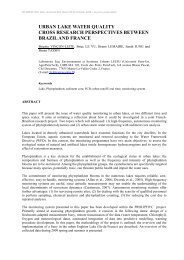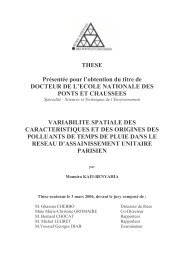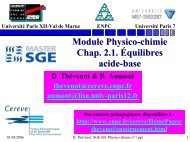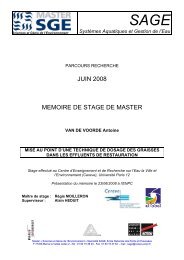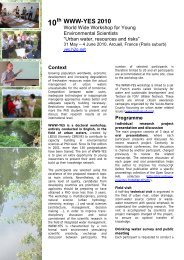View - ResearchGate
View - ResearchGate
View - ResearchGate
Create successful ePaper yourself
Turn your PDF publications into a flip-book with our unique Google optimized e-Paper software.
22 Impact of Land Use on Water Quality ofPhewa- Lake Pokhara,NepalRudra Bahadur Raya1.3 Problem statementHowever the lake and its watershed has been under immense and exhaustive pressure due toexcessive human intervention since last couple of decade.2. MATERIALS AND METHODS2.1 Study areaSEC-Nepal, pokhara 5 Tel; 977-023-580992-01-4420173Mob no 9804107720 Fax -01-4421954E-mail rudra7raya@yahoo.com rraya@nepallake.gov.np waterrudra@hotmail.comAbstractThe principle recent change in rural land use in the Pokhara valley of Nepal is thatrural area are being absorbed into growing town and cities . this conversion ofrural in to urban land has several impact on lake water quality because of developmentsuch as industrial instillations and so many hotel and restaurant which are locatedalong the bank of environmentally vulnerable lake .Phewa Lake which is a majortourist destination of Nepal is at present facing high human pressure at both its urbanand rural watershed areas .in the absence of proper sewage system in Pokhara city.High sedimentation rate of the lake has half reduced its size since 1956.The primeobjective of the water quality monitoring is to characterize the water quality of PhewaLake over a long time frame. The water quality monitoring is mainly based onquantitative determination of selected physical and chemical parametric values thatpresent in the water where various intervention have been implemented. Since theconcentration of pollution level distribution at fhewa lake is heterogeneous in nature,the stratified random sampling technique is adopted.And to provide reliable data about sedimentation in the Phewa lake , which could thenbe used to estimate and predict sedimentation rate lake storage capacity ,and itsexpected life span .The eco sounding , aerial photo and photo monitoring have given aclear picture of the sedimentation in the silt trap area . Phewa Lake is mesotrophic toeutrophic status .most of the analyzed physo chemical parameters are destructive asfound in natural surface water bodies.In such situation ,if the lake continuous to bepolluted and fill up by sediment at present rate ,its recreational and aesthetic value aswell as national economy of Pokhara ,Nepal will be diminished .Fig 1 Nepal1. IntroductionKey word: water quality, land use, pollution, sedimentation, watershed,Fig 2: Pokhara valleyFig3: Phewa lake1.1 BackgroundNepal is renowned in the world on account of her natural beauty, geographical / biologicaldiversity and culture heritage. In adequate management and unwise utilization of theseresources, despite there high potential has been undergoing several environment degradation.As a result, they may reach to a critically threatening point if adequate measures are not taken.One of such important natural area is Phewa lake in Pokhara valley .The Phewa Lake is one ofthe most beautiful place in Nepal and attracts a large number of tourists from all over theworld. By the virtue of its natural beauty, the lake contributes significantly in local andnational economy through tourist industry.1.2 Objective of the studyTo identified the concentration of pollution in the lakeTo estimate and predict sedimentation rate, lakes storage capacity and its expected life span.2.2 Method of water samplingWater samples were taken twice in a month, i.e. first and last week, from 5 stations located indifferent part of lake namely Anadu, Khapaudi, Hallan Chowk, Inlet and Outlet. Watersamples from Anadu were collected from 0m, 2.5m, 5.0m, 7.5m, 15m and 20m. Khapaudi sitepermitted samples were taken only from surface and 1m depths. Water temperature, pH andsecchi disk validity were measured in situ. Water samples for dissolve oxygen was fixed at thesite and measured by Wrinkler’s method. Nutrient analysis of water began immediately aftercollection of the samples in the laboratory. The standard methods involved in the nutrientanalysis of water were: chlorophyll-a by SCOR/UNESCO (1960), ammonium-nitrogen (NH 4-N) by Bower and Hansen (1980), nitrite +nitrate-nitrogen (NO 2+ NO 3-N) by Dowens (1978)and phosphate-phosphorus (PO 4-P) by Murphy and Rilay (1966).2.3 Method of sedimentation survey2.3.1 Echo sounding surveyWWW-YES 2008, Paris 13 – 16 May 2008 189WWW-YES 2008, Paris 13 – 16 May 2008 190



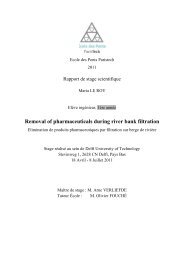
![[pastel-00730831, v1] Incidence des pratiques d'entretien ... - LEESU](https://img.yumpu.com/50938896/1/184x260/pastel-00730831-v1-incidence-des-pratiques-dentretien-leesu.jpg?quality=85)

